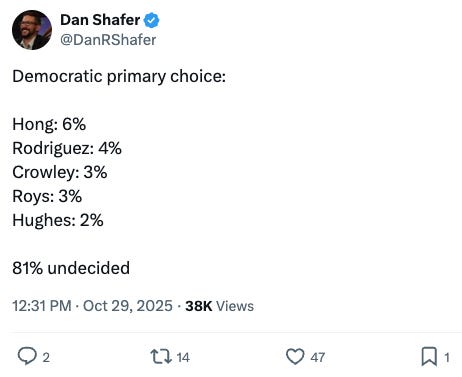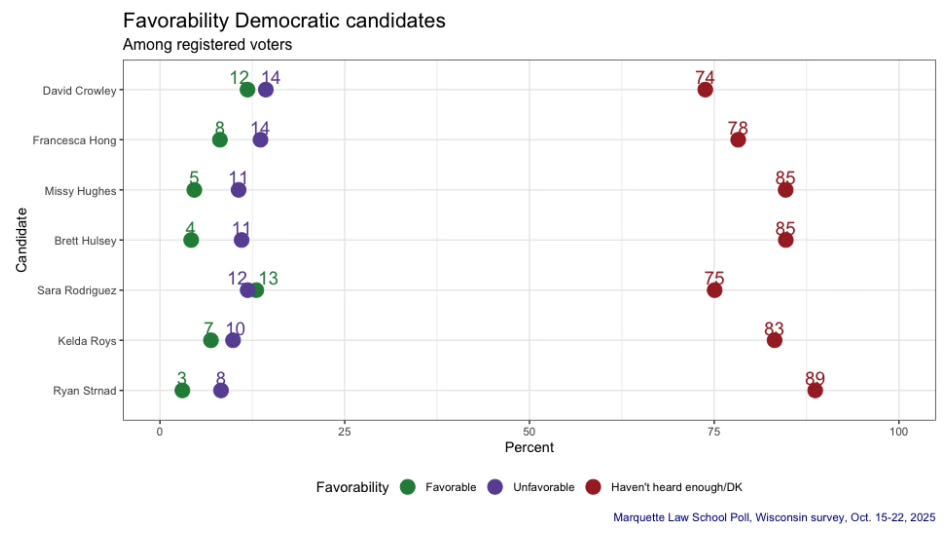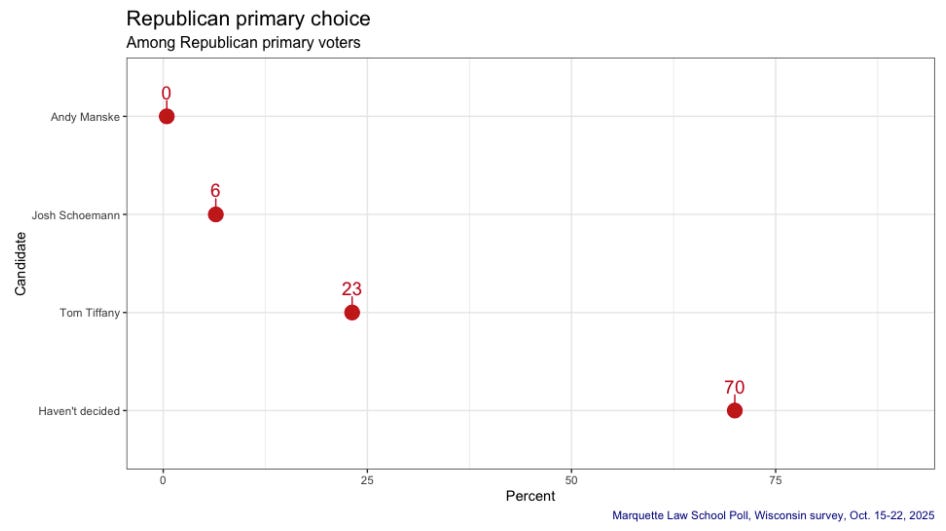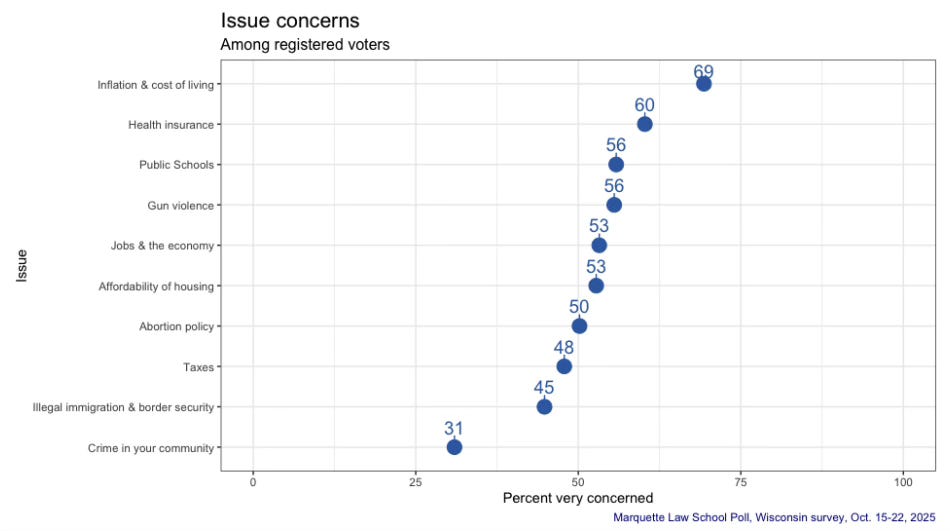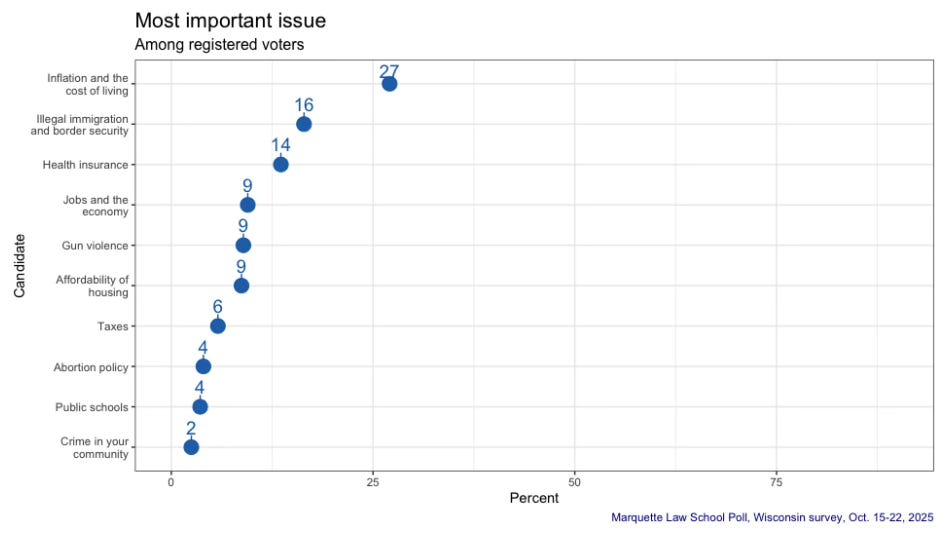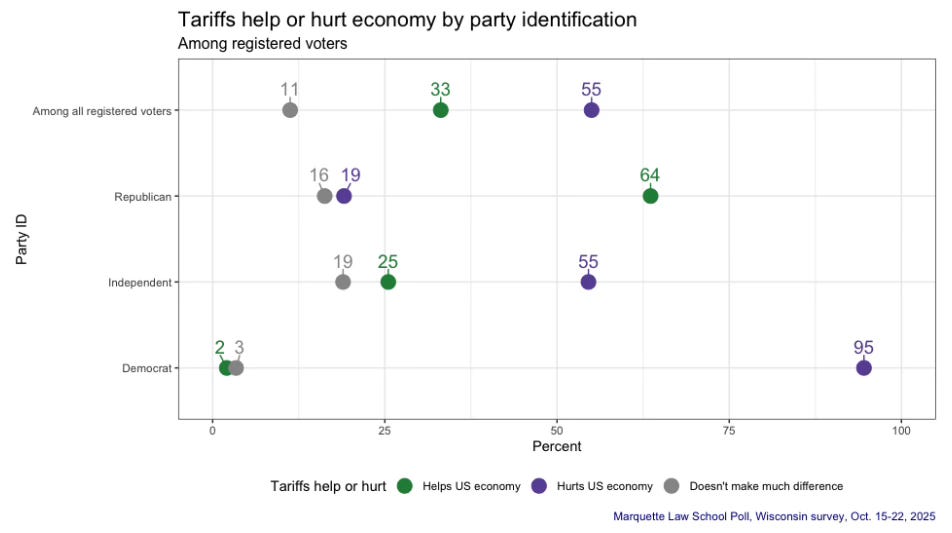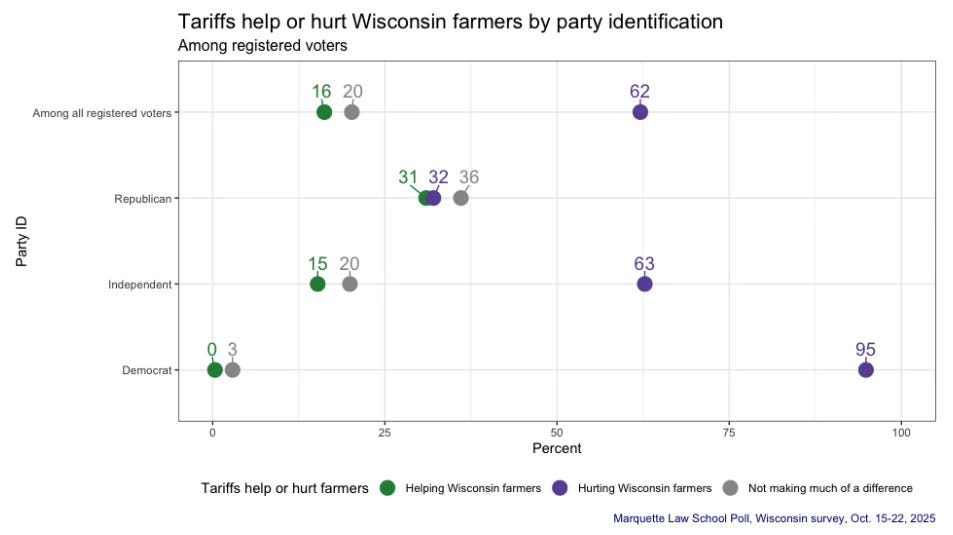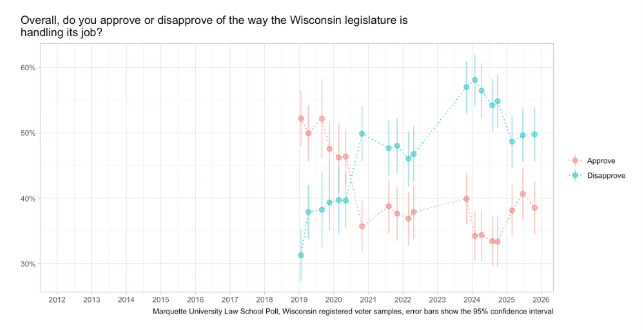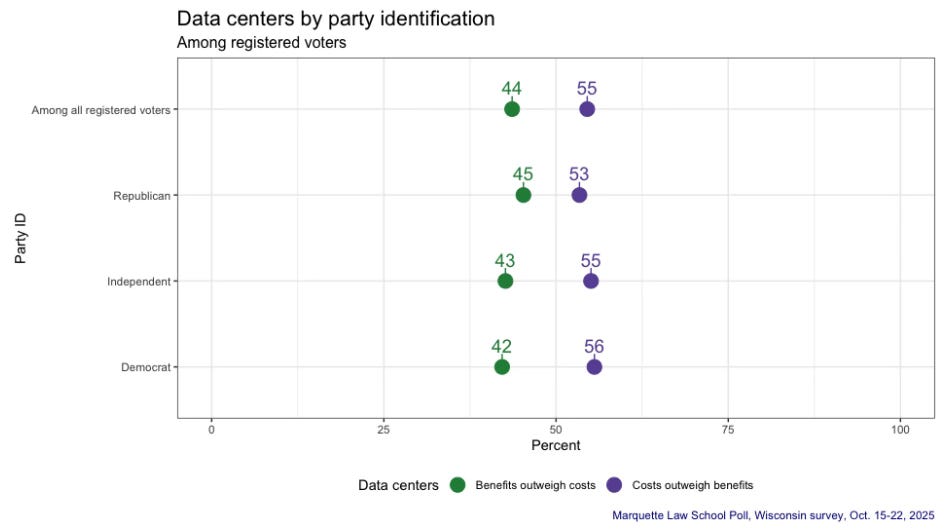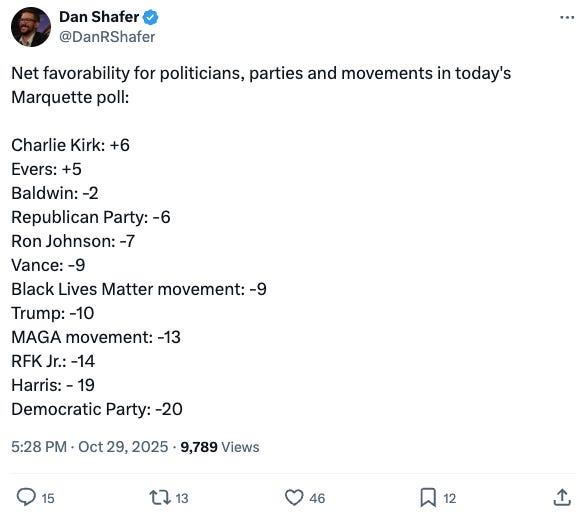7 takeaways from the October 2025 Marquette poll
We'll have to keep waiting for any meaningful data on the Democratic primary in the race for governor, but there's a whole lot here to break down.
The Recombobulation Area is a 19-time Milwaukee Press Club award-winning opinion column and online publication founded by longtime Milwaukee journalist Dan Shafer. The Recombobulation Area is now part of Civic Media.
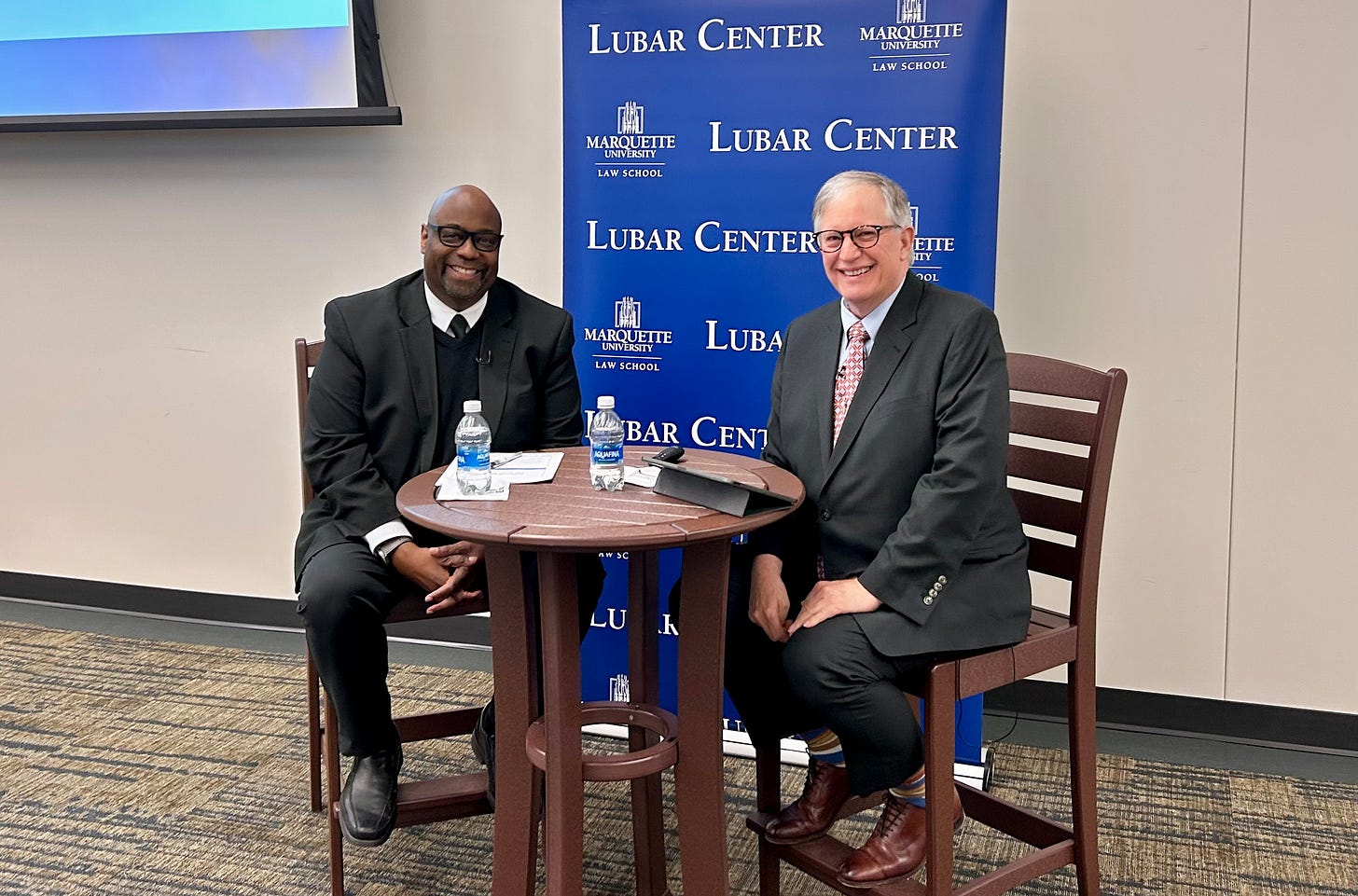
The Marquette University Law School Poll is the gold standard of measuring public opinion in Wisconsin, so here at The Recombobulation Area, we take a closer look at each new poll. See all of our previous breakdowns here.
The latest edition of the Marquette University Law School Poll was released on Wednesday, Oct. 29. We covered a few of the highlights over at
, but here at The Recombobulation Area, we are here to do our customary deep dive.So, let’s get into it. Let’s recombobulate.
1. There’s no meaningful information in the Democratic primary results
Among the highlights going into this poll, the first Wisconsin edition released since June, was that this would be the first poll of the still-emerging field for the 2026 governor’s race, the first open contest for the office since 2010. On the Democratic side, we’ve seen campaign launch announcement after campaign launch announcement in recent weeks and months, so this was going to be the first big test of how the field was taking shape.
Turns out, people are not yet engaged in this race in any way that would matter in a public opinion poll. The margin of error for the Democratic primary voters is 6.9 percentage points, and no candidate polled over 6%.
The poll also looked at favorability among each candidate, and none of the numbers on their own really stood out. The biggest thing, really, is that the field is not well known at all, with no candidate reaching even a 30% name ID number. For each of the seven candidates surveyed, more than 70% of those polled haven’t heard enough about the candidate to have an opinion of them.
With more than 80% undecided among the Democratic primary, and only 6% of all voters having heard “a lot” about the primaries, I don’t think it’s even worth doing what I would normally do here and take a deep dive into the crosstabs and look for key takeaways and so on. There’s just really not any meaningful data here, no real conclusions to be drawn. I know, I’m bummed, too.
2. Where is Josh Schoemann going in this race?
The Washington County Executive was the first candidate to declare his candidacy in this race, with his campaign launch announcement happening in May. Since then, he’s picked up no endorsements and has not polled above single digits in any poll of the Republican primary released thus far.
Here again, he fares poorly. Schoemann’s candidacy is going nowhere, plain and simple. Tom Tiffany’s entry in the race has made it clear that the 7th District congressman has far more support, and Schoemann has not yet demonstrated any way in which he’d seek to be a different type of Republican governor than Tiffany.
Schoemann is still unknown to 83% of voters, he’s barely any better on name ID even in his own media market (where he continues to try to grab headlines by bashing Milwaukee), and Tiffany has about four times the support he does. Some of the relatively unknown Democrats have been running for just a few weeks. Schoemann has been at this for six months. While there’s a lot of evidence showing how voters are not meaningfully engaged in this race, that difference still seems notable.
Who is this campaign for? Who is their base in this race? What is their path to victory? I am struggling to understand where this campaign is going, because so far, it just seems they are spinning their wheels, going absolutely nowhere.
3. Inflation issues and tariff concerns register among top economic challenges
While the candidate polling didn’t tell us much — and that was the case for the results asking about the Wisconsin Supreme Court race, too — the issue polling is more substantive in this one-year-out poll.
In the question of which issues register as “very concerning” to voters, inflation and cost of living topped the list.
Inflation and the cost of living also polled as the most important issue by a fairly comfortable margin.
The poll also asked about the effect of Donald Trump’s policies on inflation. There, it showed that 57% of voters said his policies would increase inflation, with just 30% saying it would decrease inflation. Among independent voters, 69% said that his policies increase inflation.
Voters in Wisconsin are also largely against tariffs, and recognize that these policies are hurting Wisconsin farmers.
The takeaway from this is that Trump and Republicans are going to be vulnerable on this issue. Tariffs are making it so inflation is not just a problem of the Joe Biden administration, but one for Trump, too. Polling on economic issues was Trump’s strength in his first term, and while his overall approval rating remains relatively unchanged — down a single point to 46% approve — his economic strength in polling is waning significantly.
It’s not just typically liberal areas of the state, either, in the north and west part of the state, only 12% say tariffs are helping, with 66% saying these policies are hurting Wisconsin farmers. Only 19% in the Green Bay media market say tariffs are helping farmers, same as in the heavily anti-Trump Madison market. People can see what’s happening in front of them.
Overall, tariff opposition is most pronounced in Milwaukee. No region of the state1 polled more on the tariffs-are-harmful side of that question than Milwaukee, with just 24% saying they’re helpful, 67% hurtful. Milwaukee voters also said Trump’s policies are increasing inflation more than those in any region — just 19% saying they’ll decrease inflation to 72% increase. As the GOP has worked to make inroads in the state’s largest city, Trump’s tariff policies might scuttle that path — and create an opening for Democrats to win back some voters with economic concerns.
4. The Republican-controlled state legislature remains unpopular — and that’s a bigger deal now
In more recent years Marquette has been polling approval ratings for the state’s three branches of government — Gov. Tony Evers in the executive branch, along with the Wisconsin State Legislature and Wisconsin Supreme Court. Voters remain broadly positive on Evers (a net plus-5), and the Wisconsin Supreme Court (a net plus-6), but have the most negativity over the legislative branch, a net minus-11.
This result has added significance now, as the 2026 election will offer the first real chance to flip the legislature to Democratic control in more than 15 years. With the second half of the State Senate now up for re-election under new maps, this will be the first fully post-Gerrymander election in Wisconsin’s legislature. In the State Senate, in particular, Democrats might actually be favorites right now to win the majority.
Sometimes, respondents to this question will offer their opinion on their own state legislators as opposed to the larger body, but here, approval of the GOP-controlled legislature cuts down partisan lines. Republican voters have a net plus-8 approval rating of the legislature, but that’s minus-9 among independents, and minus-33 among Democrats.
There are also far more people who “strongly disapprove” of the legislature (17%) than “strongly approve” (4%). This maps out on ideological lines, too. Only 1% of moderate or liberal voters “strongly approve” of the job the legislature is doing, and 18% of “very conservative” voters are in that “strongly approve” category. Only among very conservative or conservative voters is the legislature a net positive. Among moderates, their approval rating is a net minus-20.
Disapproval of the legislature is not just a Milwaukee/Madison issue, either. The weakest approval numbers by region are found in the Green Bay media market, with only 31% there approving of the job the legislature is doing.
If there is any branch of government in Wisconsin where the majority voters are saying they want change, it is certainly the legislature. This is worth monitoring.
5. The Affordable Care Act, and subsidies key to the shutdown, are popular
Health insurance came in at No. 2 in the list of issue concerns among Wisconsin voters, ahead of public schools, gun violence or jobs and the economy. Perhaps the raised salience of the issue, key to what Democrats have been pushing for in shutdown negotiations, have made an impact.
Blame for who is responsible for the shutdown cuts predictably along partisan lines, but a sizable majority of voters — 58% — say Congress should extend the increased tax credits for insurance purchased on the Affordable Care Act (ACA) marketplace. That includes more than half of independents, and nearly a third of Republican voters. Even in the more traditionally conservative Milwaukee area suburbs, this polls as a 50-50 issue, and extending the subsidies enjoys majority support in every other region of the state.
Overall, too, the ACA is popular, with 53% viewing it favorably to just 38% unfavorable. And 63% of independents and moderates view it favorably. Democrats don’t have many areas of strength at the moment — the party’s favorability remains at a dismal net minus-20 — but ACA and health care are still where they can win majority support.
6. Data centers are an emerging issue that doesn’t cut along traditional political lines
In Civic Media’s coverage of a public hearing over a data center in Caledonia, members of the Party for Socialism and Liberation and those for right-wing group HOT Government were there to speak out against the proposal. That might tell you a bit about how the issue of data centers is not one that follows your usual partisan lines.
Throughout the poll, almost every issue is viewed through a distinctly partisan lens. You see it over and over. But this one is different. In this poll, more voters (55%) say “the costs of the data centers outweigh the benefits,” and that breakdown is fairly similar among Republican, independent and Democratic voters.
I asked Charles Franklin about this after the poll, and he said, “This is a new issue. It’s not like we’ve had a huge debate for years about data centers, the way we have about the Affordable Care Act. So the partisan lines are not clearly drawn at this point. I think if we see partisan leadership, in particular, running campaigns and talking about these issues, you’d expect to see a greater party divide in the future. But it’s really striking that this is an example of an issue — maybe because it’s new, maybe because of the nature of the issues — that the party lines are simply not clear, and voters, therefore, don’t show any differences by partisanship on this new issue. Check back in a year or two years and see if that party divide has developed.”
7. Wisconsin voters’ views on politicians, parties and movements
This is something I’ve been examining in the last few polls — the net favorability of those polled. I’ve put those into a ranking of sorts, and I find it quite revealing on how Wisconsinites see the political landscape.
Dan Shafer is a journalist from Milwaukee who writes and publishes The Recombobulation Area. In 2024, he became the Political Editor of Civic Media. He’s written for The New York Times, The Daily Beast, Heartland Signal, Belt Magazine, WisPolitics, and Milwaukee Record. He previously worked at Seattle Magazine, Seattle Business Magazine, the Milwaukee Business Journal, Milwaukee Magazine, and BizTimes Milwaukee. He’s won 23 Milwaukee Press Club Excellence in Journalism Awards. He’s on Twitter at @DanRShafer.
Subscribe to The Recombobulation newsletter here and follow us on Facebook and Instagram at @ therecombobulationarea.
Already subscribe? Get a gift subscription for a friend.
Part of a group who might want to subscribe together? Get a group subscription for 30% off!
Follow Dan Shafer on Twitter at @DanRShafer and at BlueSky at @danshafer.bsky.social.
1. The five polled are Milwaukee City and County, Rest of Milwaukee media market, Madison media market, Green Bay media market, Rest of north & west of state.


